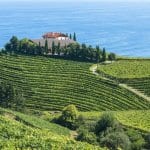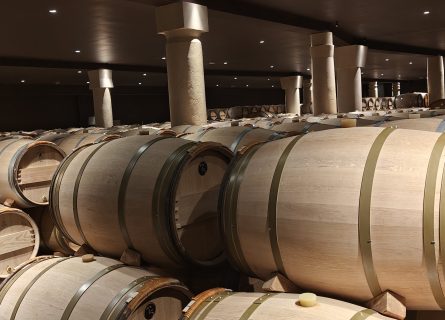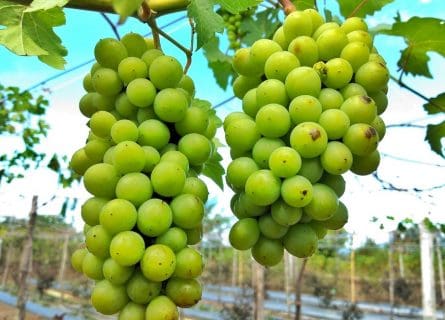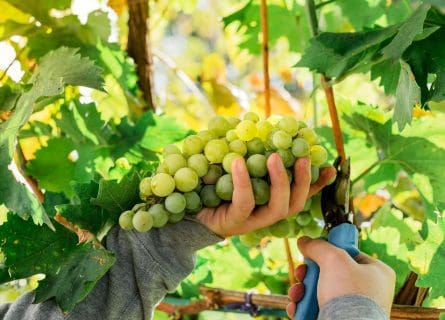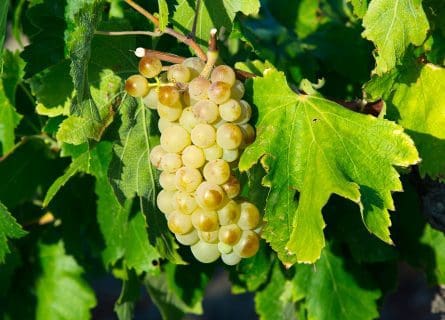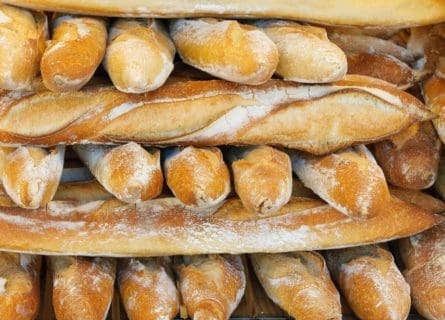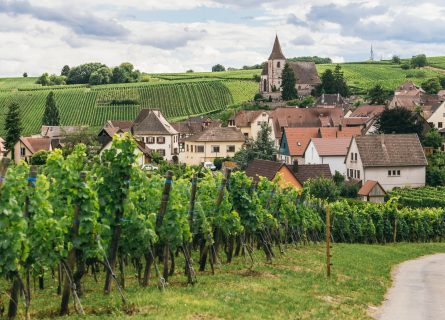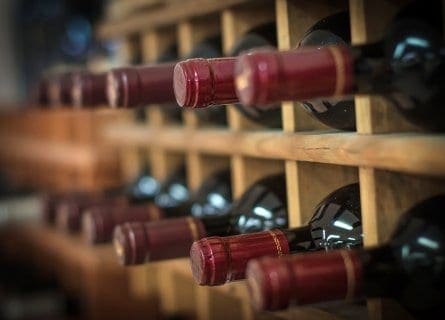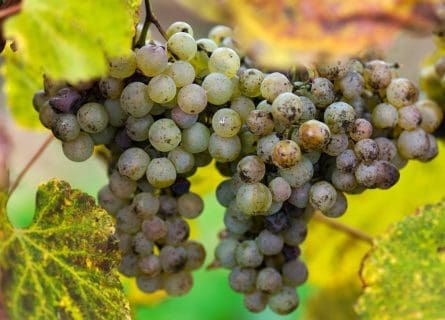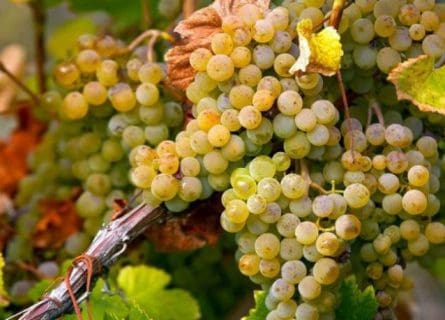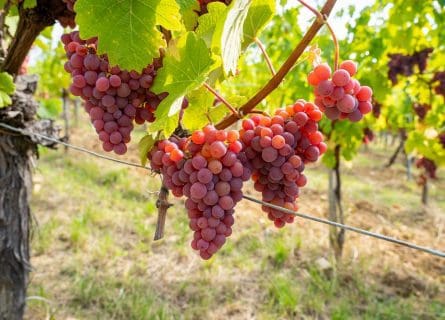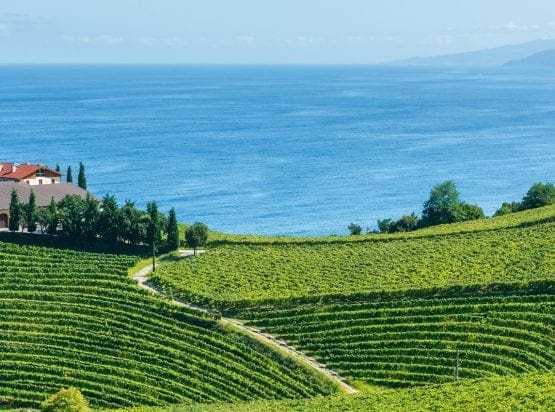
Ainhoa Travel Guide
Discover Ainhoa: Your Passport to Unforgettable Adventures! Your ultimate guide to this Basque Gem
Ainhoa is one of France’s most beautiful villages and has received this official accolade, which it deserves most. If the village were up for sale tomorrow, it would make a fortune on the location alone: nestled in the French Pyrénées region, which boasts some of Europe’s most splendid alpine scenery. It is one of the French Basque’s most beautiful gems, a charming destination in its own right, and a stone’s throw away from the glamorous coastal town of St Jean de Luz and the national parks and skiing of the Pyrénées mountain range.
Like most Basque country, this picturesque village has an early history shrouded in mystery. The first Basque settlers enjoyed an isolated existence on the Atlantic coast, primarily sheltered from outside influences. This all changed with the arrival of the Romans, who conquered Gaul (France) in the 1st century AD. This part of France was named Aquitania, or Aquitaine, by the Roman conquerors and remained under their control for centuries until the Western Empire collapsed in the 5th century.
Following the disintegration of Roman rule in France, the province of Aquitania came under the control of the Visigoth tribes from northern Europe. They, in turn, lost power to the Franks, and the Vikings captured the resort town of Biarritz in 840. Their hold over the Basque province ended in 982 when the Basque Duke William II Sanchez of Gascony defeated the Vikings in a battle for Biarritz. One of his first tasks was reintroducing Christianity to the region; monasteries soon sprung up throughout the Basque country. However, Ainhoa was only first mentioned officially in writing as a parish in the 13th century.
In the Middle Ages, Ainhoa was mainly under English control following the marriage between Henry II of England and Eleanor of Aquitaine. The King suddenly had power over the French provinces of Aquitaine and Gascony, giving him lucrative control over a key part of the Santiago de Compostela pilgrimage route. Ainhoa had long been an essential stop on the pilgrims’ path to Santiago, as many of the routes from France converged on the village, and tolls were charged to allow pilgrims to continue through to Spain. In 1238, the Navarrese King Theobald I purchased these toll rights, the village being right on the Aquitaine/Navarrese border. After that, tensions rose between the two neighboring states, and many military clashes occurred over the decades. In 1280, the ruler of Ainhoa officially recognized the suzerainty of the Duchy of Aquitaine, and tensions subsided.
However, the next century was marked by unrest and turbulence as during the 100 Years’ War, the French King Philip IV battled Edward I for control of the region. Philip kept control of the province until the Treaty of Paris in 1303; after that, it was part of the English throne. In the 17th century, the Spanish invaded the French Basque coast during the Thirty Years War, and Ainhoa was destroyed following a bloody battle for the territory. The village was rebuilt following the peace-affirming marriage between Maria Theresa of Spain and Louis XIV of France. All that remained from the destruction were the village’s church and the Machitorénéa House.
The 18th century was mainly a peaceful and prosperous time for the residents of Ainhoa, although several important events did take place during the period. In 1724, the residents of Ainhoa protested against a new salt tax, damaging their lucrative livelihood from mining, which was the mainstay of Ainhoa’s economy for many years. 1726, a massive uprising took place, and the taxes were overturned. Indeed, the French Basque region and Ainhoa enjoyed much self-determination for most of the 1700s. However, the French Revolution and subsequent abolition of the monarchy centralized the government. France’s First Republic was proclaimed, and local privileges granted by the old regime were abolished.
Ainhoa was directly affected by the outbreak of the Napoleonic wars in Europe in the 19th century. In 1813, when Napoleon’s army retreated from Spain, villages along the Basque coast were attacked and pillaged as revenge, including Ainhoa, by British and Spanish troops. During the 2nd World War, Ainhoa was under German military control as part of Vichy France, and the Nazis administered the entire Atlantic coast. However, many brave inhabitants of these Basque villages still managed to help British soldiers and French resistance fighters escape across the border to Spain.
Today, Ainhoa remains a must-visit destination on the beautiful and tranquil French Basque coast. The setting could not be better, and lovers of scenic landscapes and the outdoors are sure to fall rapidly in love with the village at first sight. Indeed, the mountains dominate life in the French Pyrénées, and in many ways, despite being in France, Ainhoa feels much closer to Spain in lifestyle and culture. The village oozes charm with its timbered, painted wood houses, beautiful churches, and delightful cafes and restaurants. It’s a destination where you are guaranteed rest and relaxation!
-
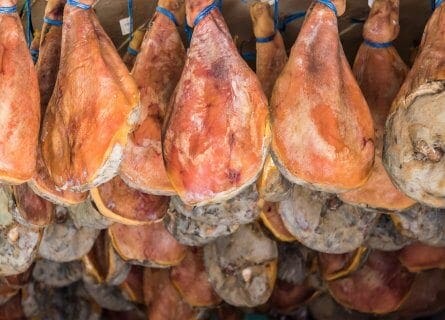
Bayonne ham Gastronomy & Wine
Basque citizens take their food and drink very, very seriously! Their passion for good food, combined with the classical Gallic sensibility about the importance of gastronomy, means that visitors are sure to enter gastronomic heaven when visiting one of the Basque country’s coastal resorts. And despite the size of Ainhoa, the variety of places to eat is impressive, with formal restaurants, cafes, and local family-run haunts for every budget and occasion.
Typically, French Basque cuisine is heavily influenced by its proximity to the Atlantic, making Ainhoa a seafood lover’s paradise. Fundamentally, Basque cooking is all about the finest, local, and seasonal ingredients rather than using creamy sauces to smother the natural flavors. Highlights in Ainhoa include fresh fish, which is unbeatable and should always be the first choice for discerning visitors. Cod, hake, and fresh tuna are popular when the oysters are in season. They sell out fast! The French influence comes across strongly, with many restaurants offering game, foie gras, and Bayonne ham as specialties. Our top choice for exquisite, refined French Basque cuisine in Ainhoa would be Ithurria on the Place du Fronton. For a more traditional and rustic experience, try the equally excellent La Maison Oppoca on Le Bourg Street.
Regarding wine production, in nearby Saint-Étienne-de-Baïgorry, you will find the intriguing Irouléguy AOC wines, with dry red, rosé, and white styles made with Bordelesa Beltza (Tannat) and Axeria (Cabernet Franc), Xuri Zerratia (Petit Courbu), and Izkiriota Ttipia (Petit Manseng). Recommended estates include Domaine Arretxea, Domaine Etxegaraya, Domaine Ilarria, Domaine Mourguy, and Vignerons du Pays Basque. Then, across the border along the Spanish Basque coast near Getaria, you will find a crisp, delicious white in the form of Txakoli. Finally, of course, local restaurants will serve a variety of French and Spanish wines.
Basque Gastronomy Guide: Read more
Nearby Wine Regions
-
 Learn about the vibrant flavors of Txakoli wine amidst breathtaking Basque landscapes. Explore our comprehensive guide. Plan your trip today! Read more
Learn about the vibrant flavors of Txakoli wine amidst breathtaking Basque landscapes. Explore our comprehensive guide. Plan your trip today! Read more
Highlights
-
Church of our lady of the Assumption
This beautiful church was built in the 13th century and is undoubtedly one of the Basque coast’s prettiest. Modifications were later made in the 17th century, including the impressive bell tower. The church’s interior features an ornate altarpiece and the two rows of balconies commonly seen in Basque churches. It was classified as a historical monument in 1996.
-
Bayonne
The capital of the French Basque country, Bayonne has been an important town since Roman times. It is not as famous as its cousin Biarritz, making it all the more attractive to visit as Bayonne simply feels like an authentic Basque town, rather than an overcrowded tourist resort!
-
Parc National Des Pyrénées
Nature lovers cannot miss the stunning National Park of the Pyrénées mountain range. It extends 100 KM along the French-Spanish frontier and contains an incredibly varied amount of flora and fauna. There are over 350KM of footpaths within the park, making it very visitor friendly and hikers fill the park in the summer months.
-
St-Jean-de-Luz
A short distance south from Ainhoa, St-Jean-de-Luz is the most quaint and delightful fishing village that explodes into life in the summer. A walk along the bustling sea-front is a real pleasure; make sure also to visit the Eglise St-Jean Baptiste. This was the sight of Louis XIV’s marriage to the Infanta Maria Teresa of Spain in 1600.
Recommended for you
More information
If you would like us to customize an exclusive luxury tour, contact us and let us know your travel plans. We offer luxury food and wine tours for private groups of a minimum two guests. In addition, all of our private, chauffeured tours are available year-round upon request.

